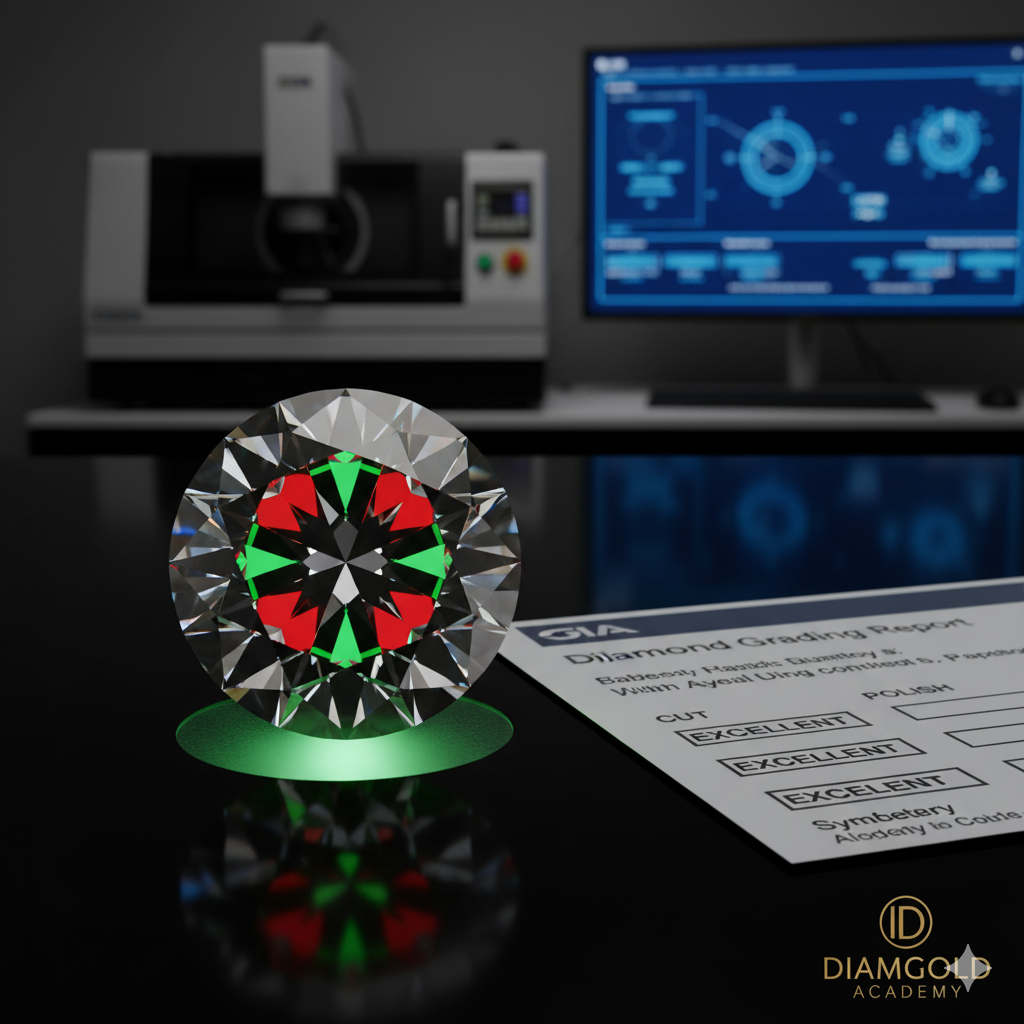✨ The Science of Sparkle: A Deep Dive into Diamond Cut Grades (Understanding Proportions, Symmetry, and Light Performance)
The diamond cut grade is arguably the most critical of the 4Cs because it is the only factor entirely determined by human skill—the craftsmanship of the cutter.1 It dictates how beautifully a diamond interacts with light, making it the single biggest factor affecting a stone’s brilliance and visual appeal. A perfect cut can make a lower-color or lower-clarity diamond look spectacular, while a poor cut will leave even a flawless, colorless stone looking dull.
For high-value, high-intent searches, understanding the nuances of cut is essential.
Breaking Down the GIA Cut Scale Explained
The Gemological Institute of America (GIA) uses a five-point scale, from Excellent (EX) to Poor (P), to grade the cut quality of a standard round brilliant diamond. The final grade is not based on a single measurement, but on the comprehensive assessment of seven components, which fall into three key performance categories:
1. Appearance-Based Components (Diamond Light Performance)
These three factors describe what you actually see when you look at a diamond:
| Component | Definition | Effect of Poor Cut |
| Brightness (or Brilliance) | The total amount of white light reflected from the interior and exterior surfaces of the diamond. | Light “leaks” out the bottom or sides, resulting in a dark, lifeless stone. |
| Fire | The dispersion of white light into the colors of the spectrum (the rainbow effect). | The stone lacks the vibrant flashes of color, appearing muted or flat. |
| Scintillation | The pattern of light and dark areas, and the flashes of light (sparkle) produced when the diamond, the light source, or the observer moves. | The sparkle is weak, uneven, or “splintery,” lacking the desired contrast and dynamic life. |
2. Design and Proportions
A diamond’s ability to achieve high Brightness, Fire, and Scintillation is purely dependent on its Diamond Proportions—the geometric relationship between its facets.
Key proportional terms you will see on a GIA report:
- Table Percentage: The width of the large, flat top facet (the table) divided by the diamond’s average diameter. A table that is too large reduces the size of the crown facets, minimizing fire.
- Ideal Range for Round Brilliant: 53% – 58%
- Depth Percentage: The diamond’s height (from the table to the culet) divided by its average diameter. This is the single most critical overall measure. If the Depth Percentage is too deep or too shallow, light escapes.
- Ideal Range for Round Brilliant: 59% – 62.6%
- Crown Angle: The angle at which the top facets meet the girdle. This angle heavily influences the balance between Brilliance (white light) and Fire (color).
- Ideal Range for Round Brilliant: 34° – 35°
- Pavilion Angle: The angle of the bottom facets (the pavilion). This is the “engine” of light return. If this angle is too shallow, light reflects off the bottom and exits the side (“fish-eye”). If it’s too steep, light leaks out the bottom (“nailhead”)
- Ideal Range for Round Brilliant: 40.6° – 41.0°
3. Craftsmanship
The final grades assessed are for the precision of the physical cutting:
- Polish: Refers to the smoothness of the diamond’s facets.1Poor polish can leave microscopic lines that diminish Brightness.
- Symmetry: Refers to the exact alignment of the diamond’s facets. Poor Symmetry creates an uneven pattern of light return, resulting in a lopsided sparkle.
The Ideal Cut Diamond Legacy: AGS Influence
While the GIA created the 4Cs, the American Gem Society (AGS) Laboratories pioneered the scientific analysis of Diamond Cut Quality.
- AGS Ideal Cut: The AGS historically used a numerical scale of 0 to 10, with 0 designated as the “AGS Ideal Cut.” The AGS system was long considered stricter and more scientifically rigorous than early GIA cut grades because it was based on scientific light ray tracing and the Angular Spectrum Evaluation Tool (ASET) to precisely measure light leakage.
- Influence on GIA: The AGS Ideal Cut philosophy, which focused on light performance over mere measurements, pushed the GIA to refine its own system. In 2005, when the GIA introduced its first formal Cut Grade, the Excellent grade was designed to encompass the very best cutting styles, including those that previously qualified as AGS Ideal.
- Modern Equivalence: Today, the top tier of diamond quality is generally referred to as “Triple Excellent” (EX/EX/EX) on a GIA report (Cut, Polish, and Symmetry) or AGS Triple Ideal (0/0/0). Both represent stones cut to maximize Diamond Brilliance.
Cut vs Clarity and Why Cut is the Winner
For the vast majority of consumers, prioritizing Cut Grade over Clarity or even Color is the best strategy.
A diamond with a lower clarity grade (like VS2 or SI1, where inclusions are often eye-clean) but an Excellent Cut will reflect so much light (Diamond Brilliance) that any minor internal flaws are masked by the sparkle. Conversely, a Flawless (FL) diamond with a Poor Cut will look dull and fail to sparkle, wasting the investment made in its high clarity.
The Golden Rule: Never compromise on an Excellent (GIA) or Ideal (AGS) Diamond Cut Grade.
Cultivate Precision: Jewelry Manufacturing and Cut Quality
The pursuit of the perfect Diamond Cut Grade is where gemology meets master craftsmanship. Achieving an Excellent/Ideal Cut is technically demanding, requiring the cutter to sacrifice raw carat weight to maximize optical performance.
At Diamgold Academy, our Jewelry Manufacturing and Gemstone Identification courses focus intensely on the physics and geometry of light. Students learn not just to identify a high-quality cut but to understand the cutting and polishing techniques—the precision required in every facet’s angle and alignment—that bring a rough stone to its maximum potential Diamond Brilliance. Investing in this knowledge is the key to mastering diamond value and quality.
